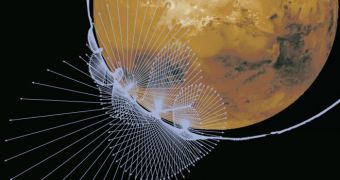As some of you may know, the idea of ancient asteroids smashing off on the Martian surface and shutting down most of the planet's magnetic field is not new, and we've already written about it in a previous article. But a recent study provides more insight on how this may have happened, aided by new data obtained on the features of the red planet and by computer simulations of its past asteroid activity.
During its very early years, Mars is thought to have looked very similar to the young Earth, water abundant, hot, and featuring a molten core and mantle, the liquefied matter of which helped forming a dynamo that, in turn, shielded the planetary surface and atmosphere from cosmic radiation. But 4.2 billion years ago, some 20 mammoth asteroids between 200 and 500 km (124 and 311 miles) wide (20 to 50 times larger than the one believed to have wiped off the Earth's dinosaur species) smashed on the Martian surface with enormous force, leaving large and deep scars.
Among the last ones to hit around 4.1 billion years ago, a gigantic meteorite that crushed on Mars' northern hemisphere left behind a 3,000 kilometer (1,864 miles) wide crater known as the Utopia basin, its rocks showing no sign of magnetic activity. A group of researchers led by James Roberts from the University of California tried to determine the effect of the impact on the internal dynamo that fueled the magnetic field of the planet.
The energy amount released in the collision was 10 trillion times higher than that of the Hiroshima bomb, and its generated heat and Shockwave spread instantly across the Martian surface. The extremely hot mantle prevented the core from fueling a magnetic field on a planetary scale for the next 30 million years, and as the mantle cooled, the dynamo lacked the necessary energy to resume its activity. That is why Mars only shows sporadic and reduced magnetic field activity.

 14 DAY TRIAL //
14 DAY TRIAL //